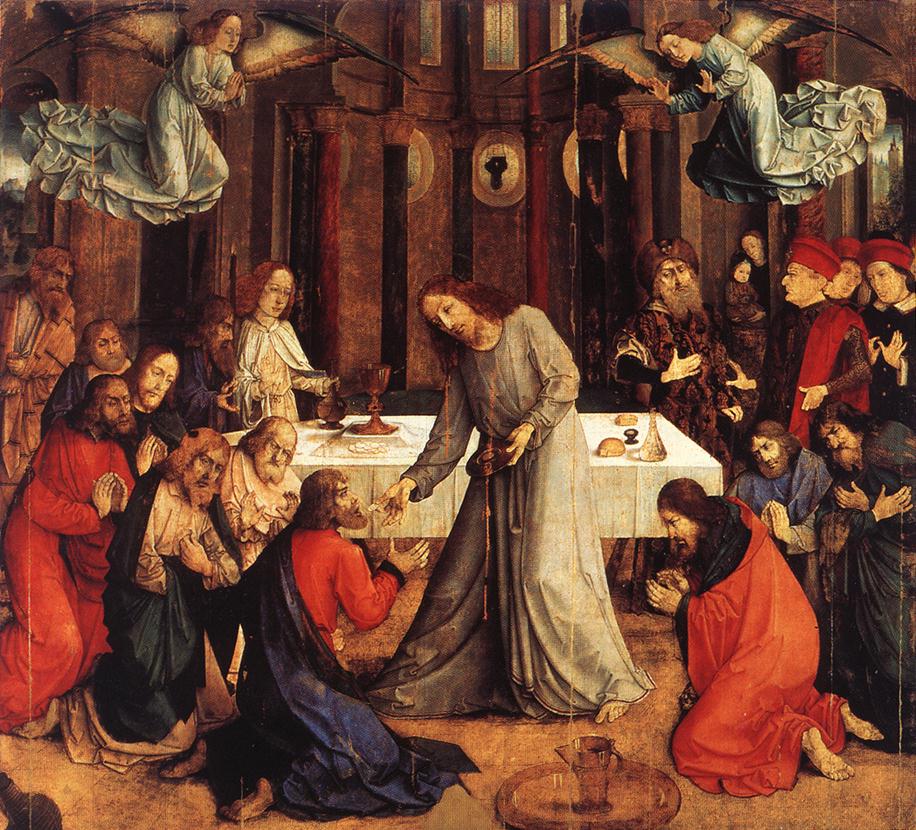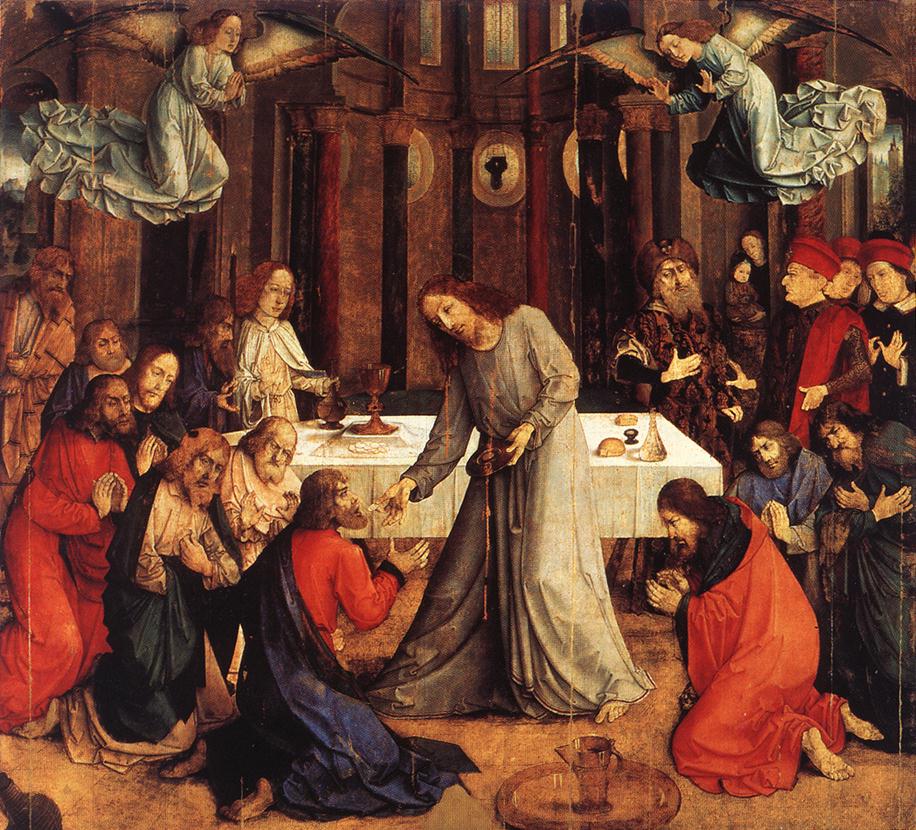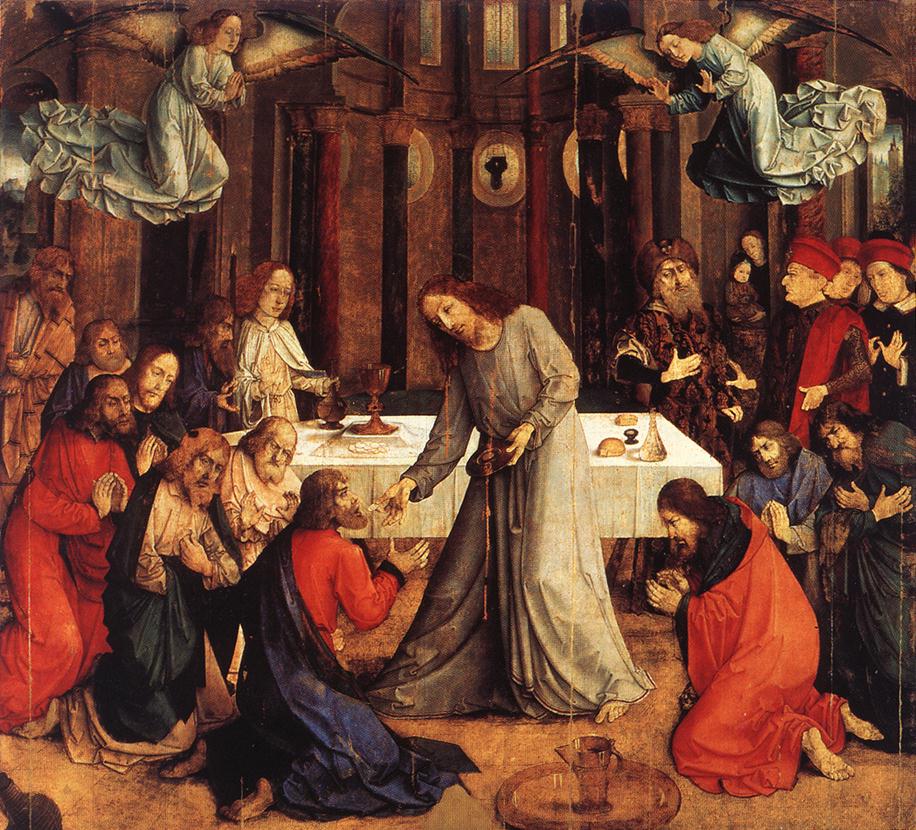 This article is by Dr Caroline Farey of the Maryvale Institute. She and I worked together to design the Institute's degree level diploma (6 US credits): Art, Beauty and Inspiration in a Catholic Perspective. A distance learning course requiring one residential weekend, this can be taken either by application tothe Institute in Birmingham, England; or in the US through their centre based at the Diocese of Kansas City, Kansas (link here). Dr Farey writes:
This article is by Dr Caroline Farey of the Maryvale Institute. She and I worked together to design the Institute's degree level diploma (6 US credits): Art, Beauty and Inspiration in a Catholic Perspective. A distance learning course requiring one residential weekend, this can be taken either by application tothe Institute in Birmingham, England; or in the US through their centre based at the Diocese of Kansas City, Kansas (link here). Dr Farey writes:
Between 1465 and 1474, Giusto executed the Communion of the Apostles (The Institution of the Eucharist) which Vasari has described, and is now in the museum of Urbino. It was painted for the brotherhood of Corpus Christi at the bidding of Frederick of Montefeltro, who was introduced by Caterino Zeno, a Persian envoy at that time on a mission to the court of Urbino. Giusto is Joos van Wassenhove who was a Netherlandish painter, part of whose career was spent in Italy, where he was known as Giusto da Guanto (Justus of Ghent). He brought to Italy some of the characteristics of Dutch painting and combined them with the local Italian style.
This painting unites Jesus Christ, the Church and the Eucharist in a single harmonious illustration of the Catholic faith. It is perhaps important to begin with an initial teaching point: it is worth helping people realise that such a painting as this is has both an historical and a contemporary dimension to it. We do not need to believe, therefore, that the artist wishes us to see every part of the painting as an historical depiction. He is not necessarily wishing to communicate to us that the upper room really looked like this, or that the table was historically laid out like this, or that the apostles necessarily knelt to receive the body and blood of Christ as he has painted it here. Of course, they may have done. However, what the artist is also trying to show us in the painting is that what Christ did at the last supper with the apostles he, personally, still does for his disciples today at Mass.
One way to introduce this painting to those whom we are catechising is to begin by teaching about the Gospel accounts of the Last Supper from this piece of art. Then we can continue by explaining what the painting reveals about Mass today.
Christ at the Last Supper
 Let us look at this painting first of all as depicting an event in the life of Christ.For this we can follow the Gospel accounts, especially that of St Luke.
Let us look at this painting first of all as depicting an event in the life of Christ.For this we can follow the Gospel accounts, especially that of St Luke.
- In the Gospel of Luke chapter 22 we read that, during the Last Supper, a dispute arose amongst the disciples as to who was the greatest. Jesus replied to them ‘which is the greater, one who sits at table or one who serves? Is it not the one who sits at table? But I am among you as one who serves’(Lk 22:27).Much in this painting depicts this dialogue. The Persian in the turban and the members of the confraternity in the red hats are disputing and Christ is portrayed as the one who is not sitting at table now but is among his disciples, serving.Look at the bending figure of Christ, beautifully depicting the reality of Christ the Servant.
- We can also see here an artistic depiction of the central truth of the Faith, that God condescended to be born and to live among us, that the divine Second Person of the Trinity took flesh for our sake In the General Directory for Catechesis the part on the Pedagogy of God opens with a quotation from Hosea, ‘I became to them as one who eases the yoke on their jaws, and I bent down to them and fed them’ (Hos 11:4, in GDC 137). The bending figures of the apostles around Christ also emphasises this mystery. By contrast, the Persian in the turban stands erect, with his head and shoulders thrown back. The painting is also showing us the amazing truth that Christ only ever serves himself to us – ‘This is my Body’. The Church, in her Tradition, follows this truth without deviation, accepting that Christ gives his whole self to us.
- Christ, the one who serves, is portrayed as ‘greater’ by his stature and centrality in the picture. You can see that Christ is painted disproportionately larger in height than any other figure.
- Directly in front of Christ on the floor we can see the jug of water and basin.The Gospel of Lukes tell us that the disciples were to meet a man carrying a jar of water and to follow him into the house which he enters (Lk 22:10).
- John’s Gospel also links the Last Supper scene to water: ‘He rose from supper, laid aside his garments …poured water into a basin and began to wash the disciples’ feet’ (Jn 13: 4-5). It seems that in this painting this may have already happened – look at the bare feet in the picture!
- John’s Gospel also speaks of Judas as the one with the money box, or bag (Jn 13:29), and we can see him in this painting clutching a moneybag in both hands, looking back into the room as he edges out of the open doorway into the night with dawn breaking already in the distance.
 Eleven reverent apostles remain, three kneeling on the right and eight on the left. One in white at the back, perhaps the young John, still holds a bottle as though he had been serving, too, with his other hand raised as he gazes adoringly at Christ.
Eleven reverent apostles remain, three kneeling on the right and eight on the left. One in white at the back, perhaps the young John, still holds a bottle as though he had been serving, too, with his other hand raised as he gazes adoringly at Christ.
- The one next to him is quite different. See how he seems to be staring intently at the disputants.He is holding a lighted candle, representing perhaps the light of faith, of truth, of Christ. He has seen the truth of Christ as the greater who has come among them as a servant and longs for the disputants to be enlightened by this same truth!
Christ in His Church
Let us look now for every indication that the painter is portraying Christ as present and active in his Church. What does the picture tell us about the Mass as it is celebrated in the Church?
·The building is the first sign, with its pillars and its windows portrayed like the apse of a Cathedral Church.
·The sanctuary lamp hangs directly above the figure of Christ, in shadow in the central round window between the pillars of the apse where the tabernacle would usually be found.
·The table is painted as though an altar, and the chalice and sacred hosts are placed as though on the altar at Mass.
·The apostle in white at the back on the left hand side acts like a server acolyte at Mass and the one beside him carries a tall candle.
·The jug and basin directly in front of Jesus remind the congregation of the sprinkling of water that can take place before mass on Sunday to remind us of our Baptism.
·Christ takes up the position that we normally associate with the priest.The priest is called ‘in persona Christi’, ‘in the person of Christ’ at this moment of distribution of the sacred species and throughout the Mass.
- The apostles are painted kneeling and receiving the body of Christ on the tongue, as they would have done for most of the Church’s history until recently, as a sign of the holiness of the moment, hence the use for many centuries of the name ‘holy communion’.
This is the greatest moment possible on this earth of communion with Jesus, the Son of God, and it is the holiest moment possible, receiving the body and blood of Christ himself. The angels kneeling and adoring above the scene help to indicate this holiness.


